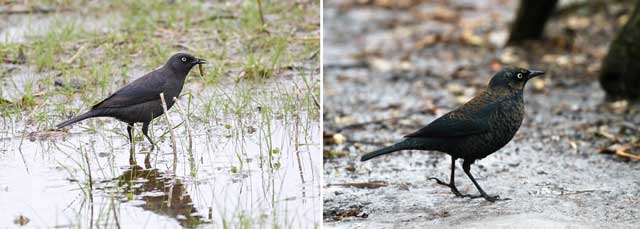Rusty blackbird
Scientific name: Euphagus carolinus

Photo credit: Michael H. King CC 4.0 International Public License
Status
Special Concern
“Special Concern” means the species lives in the wild in Ontario, is not endangered or threatened, but may become threatened or endangered due to a combination of biological characteristics and identified threats.
Date added to the Species at Risk in Ontario List
August 1, 2018
What it looks like
The Rusty Blackbird is a medium-sized songbird that ranges from 21 to 25 centimetres in size. Both sexes have pale yellow eyes and a slender black bill. During the breeding season, males are dark black with a faint green and purple gloss, and females are brownish grey. In the winter, both sexes are more rust-coloured.
Where it lives
The Rusty Blackbird breeds in habitats that are dominated by coniferous forest with wetlands nearby including bogs, marshes and beaver ponds. During the winter, it is found in wet woodlands, swamps, and pond edges and often forages in agricultural lands.
Where it’s been found in Ontario
The Rusty Blackbird is only found in North America. It breeds in every province and territory in Canada and migrates to most of the central and eastern United States for winter. In Ontario, the breeding range is found in the Hudson Bay Lowlands and northern Boreal Shield ecozones. Approximately 86 percent of the global population breeds in Canada.
What threatens it
The majority of threats that impact on the Rusty Blackbird are within their stopover and wintering habitats. The conversion of wetland forests in its wintering habitat in the United States for residential development and agriculture is considered to be one of the most significant threats to the species. Other factors include changes in surface hydrology through dam development, blackbird control programs and mortality from pesticides. Threats to its breeding habitat in Ontario include the negative impacts of climate change and industrial landscape-level activities on forest and wetland habitats.
Actions we are taking
Special concern species do not receive species or habitat protection, but may be eligible for grants to help with their protection and recovery.
What you can do
Report a sighting
- Report a sighting of an endangered animal or plant to the Natural Heritage Information Centre. Photographs with specific locations or mapping coordinates are always helpful.
- Bird Studies Canada is working to advance the understanding, appreciation and conservation of wild birds and their habitat in Ontario and elsewhere; for more information on how you can help, visit: bsc-eoc.org.
- As with all wildlife, don’t disturb or harass the birds or nesting sites. Be respectful and observe from a distance.
Volunteer
- Volunteer with your local nature club or provincial park to participate in surveys or stewardship work focused on species at risk.
Be a good steward
- Private land owners have a very important role to play in species recovery. If you find Rusty Blackbird on your land, you may be eligible for stewardship programs that support the protection and recovery of species at risk and their habitats.
Report illegal activity
- Report any illegal activity related to plants and wildlife to
1-877-TIP-SMNR (847-7667) .
Quick facts
- The Rusty Blackbird can easily be confused with the Brewer’s Blackbird that has a longer tail and legs, and glossier feathers.
- This species forages in shallow water and under leaf litter looking for aquatic prey.
- In Ontario, Rusty Blackbirds tend to nest in isolated pairs but are known to nest in loose colonies in the Atlantic provinces.